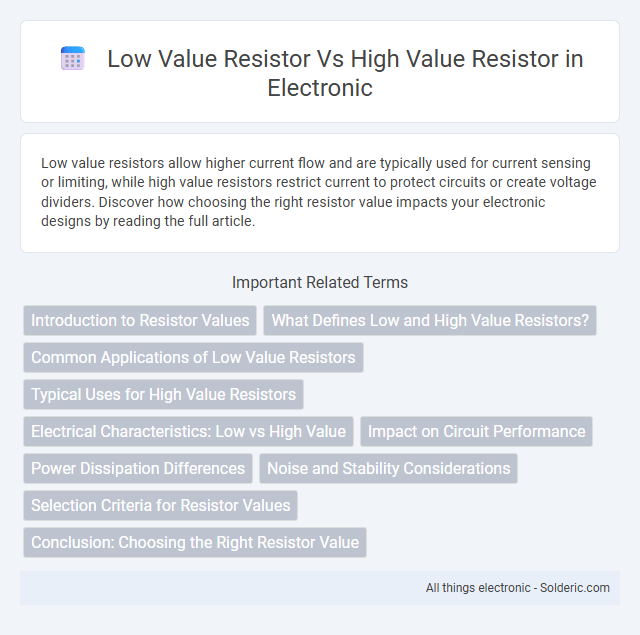Low value resistors allow higher current flow and are typically used for current sensing or limiting, while high value resistors restrict current to protect circuits or create voltage dividers. Discover how choosing the right resistor value impacts your electronic designs by reading the full article.
Comparison Table
| Feature | Low Value Resistor | High Value Resistor |
|---|---|---|
| Resistance Range | 0.1 O to 1 kO | 1 MO and above |
| Current Handling | High current capacity | Low current capacity |
| Power Dissipation | Higher power rating, suitable for power circuits | Lower power rating, used in signal circuits |
| Tolerance | Typically +-1% to +-5% | Typically +-1% to +-10% |
| Applications | Current sensing, power regulation | Voltage division, signal conditioning |
| Noise | Generally lower noise | Higher noise due to higher resistance |
| Size | Often larger due to heat dissipation | Smaller, less heat generated |
Introduction to Resistor Values
Low value resistors, typically ranging from milliohms to a few ohms, are used in applications requiring minimal resistance to current flow, such as current sensing and power regulation. High value resistors, with resistance in the megaohms, limit current significantly and are crucial in voltage division, signal conditioning, and high-impedance circuits. The choice between low and high value resistors depends on the desired electrical characteristics and circuit functionality.
What Defines Low and High Value Resistors?
Low value resistors typically range from milliohms to a few ohms, designed to handle high currents with minimal voltage drop, commonly used in power circuits and current sensing applications. High value resistors span from hundreds of kilo-ohms to mega-ohms, employed to limit current flow and divide voltages in low current circuits such as signal processing. The defining factor between low and high value resistors is the resistance magnitude in ohms, which directly influences their application, power rating, and tolerance characteristics.
Common Applications of Low Value Resistors
Low value resistors, typically ranging from milliohms to a few ohms, are commonly used in current sensing, power management, and load testing applications due to their ability to handle high currents with minimal voltage drop. These resistors are essential in circuits like battery management systems, motor controls, and power supplies to provide accurate current measurements and protect components. High power rating and low thermal resistance further enhance their performance in demanding environments.
Typical Uses for High Value Resistors
High value resistors, typically ranging from megaohms to gigaohms, are commonly used in applications requiring minimal current flow, such as in voltage dividers for sensitive measurement devices and in circuits for leak detection or static discharge control. They are essential in biasing transistors and in feedback networks where fine control of current is necessary without significantly loading the circuit. Their high resistance ensures low power consumption and reduces signal interference in precision electronic components.
Electrical Characteristics: Low vs High Value
Low value resistors typically exhibit lower resistance in the range of milliohms to a few ohms, enabling higher current flow with minimal voltage drop and power dissipation. High value resistors, ranging from kilo-ohms to mega-ohms, limit current significantly while allowing higher voltage across the resistor, which is crucial in voltage division and signal conditioning applications. The electrical characteristics of low value resistors emphasize precision and low thermal noise, whereas high value resistors prioritize high resistance stability and reduced leakage currents.
Impact on Circuit Performance
Low value resistors typically allow higher current flow, reducing voltage drop and power dissipation in circuits, which improves signal strength and response time but may increase heat generation. High value resistors limit current, enhancing energy efficiency and reducing noise, but can cause slower circuit response and voltage stability issues, especially in timing or sensor applications. Selecting the appropriate resistance value is critical for balancing power consumption, signal integrity, and thermal management in electronic designs.
Power Dissipation Differences
Low value resistors typically dissipate higher power due to increased current flow, making thermal management crucial for maintaining circuit stability. High value resistors, with lower current, generally dissipate less power, reducing heat generation and allowing for simpler packaging. Understanding these power dissipation differences helps you select the appropriate resistor for efficient and reliable circuit design.
Noise and Stability Considerations
Low value resistors typically generate less thermal noise due to their lower resistance, making them ideal for precision circuits requiring low noise performance. High value resistors, while offering higher impedance, tend to produce more noise and are more sensitive to environmental factors, which can affect stability over time. Choosing the right resistor value is crucial for your design to balance noise levels and ensure reliable operation under varying conditions.
Selection Criteria for Resistor Values
Selection criteria for resistor values depend on the desired current flow and voltage drop in a circuit, with low-value resistors typically chosen for current sensing or limiting applications due to their minimal resistance and power dissipation. High-value resistors are selected to control voltage division, reduce current to sensitive components, and minimize power consumption in high-impedance circuits. Accurate tolerance, power rating, and noise characteristics are critical factors influencing the choice between low and high resistor values to ensure optimal performance and reliability.
Conclusion: Choosing the Right Resistor Value
Selecting the right resistor value depends on the specific circuit requirements, where low value resistors are ideal for controlling large currents with minimal voltage drop, while high value resistors are suited for limiting current and protecting sensitive components. Your choice should balance power dissipation, signal integrity, and desired current flow to ensure optimal performance and reliability. Accurate resistor selection enhances circuit efficiency and prevents component damage.
Low value resistor vs high value resistor Infographic

 solderic.com
solderic.com